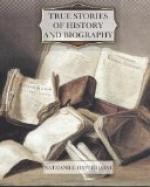“He was a bold fellow,” observed Charley, who was himself somewhat addicted to a similar mode of settling disputes.
“More bold than wise,” replied Grandfather; “for complaints were carried to the king, and Sir William Phips was summoned to England, to make the best answer he could. Accordingly he went to London, where, in 1695, he was seized with a malignant fever, of which he died. Had he lived longer, he would probably have gone again in search of sunken treasure. He had heard of a Spanish ship, which was cast away in 1502, during the lifetime of Columbus. Bovadilla, Roldan, and many other Spaniards, were lost in her, together with the immense wealth of which they had robbed the South American kings.”
“Why, Grandfather,” exclaimed Laurence, “what magnificent ideas the governor had! Only think of recovering all that old treasure, which had lain almost two centuries under the sea! Me thinks Sir William Phips ought to have been buried in the ocean, when he died; so that he might have gone down among the sunken ships, and cargoes of treasure, which he was always dreaming about in his lifetime.”
“He was buried in one of the crowded cemeteries of London,” said Grandfather. “As he left no children, his estate was inherited by his nephew, from whom is descended the present Marquis of Normandy. The noble Marquis is not aware, perhaps, that the prosperity of his family originated in the successful enterprise of a New England ship carpenter.”
Chapter III
“At the death of Sir William Phips,” proceeded Grandfather, “our chair was bequeathed to Mr. Ezekiel Cheever, a famous school-master in Boston. This old gentleman came from London in 1637, and had been teaching school ever since; so that there were now aged men, grandfathers like myself, to whom Master Cheever had taught their alphabet. He was a person of venerable aspect, and wore a long white beard.
“Was the chair placed in his school?” asked Charley.
“Yes, in his school,” answered Grandfather; “and we may safely say that it had never before been regarded with such awful reverence—no, not even when the old governors of Massachusetts sat in it. Even you, Charley, my boy, would have felt some respect for the chair, if you had seen it occupied by this famous school-master.”
And here Grandfather endeavored to give his auditors an idea how matters were managed in schools above a hundred years ago. As this will probably be an interesting subject to our readers, we shall make a separate sketch of it, and call it
THE OLD-FASHIONED SCHOOL
Now imagine yourselves, my children, in Master Ezekiel Cheever’s school-room. It is a large, dingy room, with a sanded floor, and is lighted by windows that turn on hinges, and have little diamond shaped panes of glass. The scholars sit on long benches, with desks before them. At one end of the room is a great fire-place, so very spacious, that there is room enough for three or four boys to stand in each of the chimney corners. This was the good old fashion of fire-places, when there was wood enough in the forests to keep people warm, without their digging into the bowels of the earth for coal.




